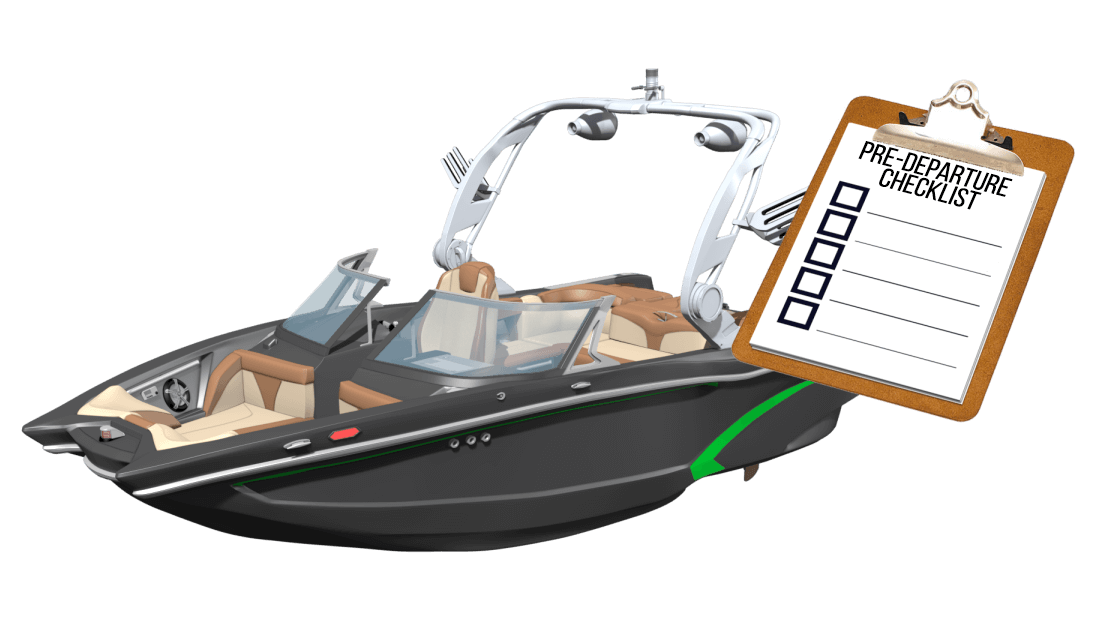Pre-Departure Checklist Boat Safety & Equipment Checklist
What is a pre-departure checklist for boating?
A good way to avoid unwanted surprises on the water is to complete a pre-departure checklist before each trip. A pre departure checklist is easy to review, and it ensures that you don't get caught on the water unprepared. It is also useful to keep new passengers informed and comfortable.

Common sense tells us that we should check everything about our boat before leaving the dock to prevent an unpleasant situation.
What should be included in my pre-departure checklist?
Personal Flotation Devices (PFDs)
-
At least one Coast Guard approved device per passenger and a minimum of two on board.
-
An additional throwable device is required if the vessel is more than 16 feet long.
-
Explain the location and use of all PFDs to passengers and crew that may be new to the vessel.
Sound Producing Devices (Whistle)
- Must have a horn capable of producing a four-second blast audible for at least 1/2 mile.
- If a portable air horn, have a spare can of air or an alternate device.
Lights and Shapes
- All navigation lights as required.
- Instrumental lights working.
- If you intend to engage in an activity that requires a day shape, have the required shapes.
- Flashlight on-board.
Distress Signals
-
Accessible flares, day signals, etc., stored in a dry location.
-
Carry signals at all times even if not required by the Coast Guard.
-
Inform the crew and passengers of their location and their use.
Tools and Spares
-
Basic tool box on-board.
-
Box of spares aboard, e.g., fuel filter, light bulbs, head parts, through hull plugs, etc.
Ventilation
-
On any powered vessel or auxiliary powered sailboat, or vessels using LPG for cooking or heat, check that all interior spaces are well ventilated before departure.
-
If fuel smells are detected before ventilating, check after running the blowers for several minutes before starting.
-
If odor persists, stop and look for the source of the leak.
Fire Extinguishers
-
Accessible fire extinguisher. Do you have at least those required by the U.S.C.G.?
-
Check to be sure mounts are secure and functional before departure.
-
Take the time to point out locations to passengers and crew.
Fuel and Oil
-
Are your tanks topped-off?
-
If not, have enough fuel to provide a reasonable margin of safety for your return.
-
Check the engine oil and coolant level.
Bilges
-
Check to be sure bilges are reasonably dry and that pumps are not running excessively.
-
Clean up any spilled oil or waste in bilges so as to prevent overboard discharge.
Battery
-
If you have a dual charging system, is the selector switch in the proper position?
-
Is the power on to the entire vessel?
-
Spare batteries for accessories such as a handheld radio, flashlight, portable navigational aid, etc.
-
If they are rechargeable, are they charged?
Weather Forecast
-
Did you check the weather forecast?
-
Radio on board to receive weather updates.
Docking and Anchoring
-
At least one anchor set up and bent-on to your anchor line.
-
Two or three extra docklines in case of unusual conditions dockside.
-
Visually inspect the lines you use for chafe or wear.
-
At least two fenders on-board for docking or towing if required.
Documentation
-
Have the ship's papers, radio license, fishing permit, etc. on board.
-
Have the chart or charts for the area you intend to cruise in, regardless of your level of local knowledge.
Boat Operator Safety Orientation
Before departure, the boat operator should review the following emergency equipment with everyone on board
-
Locate PFDs, explain when to put them on, demonstrate how, and emphasize the importance of proper fit.
-
Locate fire extinguishers and explain their use if there is a fire emergency.
-
Locate required flares (VDS) and explain why, when and how they are used.
-
Point out the location of your first aid kit.
-
Point out Oil Pollution Placard and Save Our Seas Placard (if required) and explain details of discharging waste and waste management procedures.
-
Point out location of anchor and give brief explanation of its use and how to deploy.
-
Explain operation of the Marine Radio (if equipped) and explain its use during an emergency.
-
Have a discussion of weather watching and explain passenger/crew duties and responsibilities in the case you encounter heavy weather.
-
Prior to docking or undocking, explain fully the procedures for line handling. Use terms describing lines that the passengers/crew can understand or explain the terms you use.
-
Explain what to do in case of operations emergencies such as loosing steering, loosing an engine, etc.
-
Explain procedures and responsibilities of passengers and crew in case of a crew overboard situation.
-
Appoint others on board to serve as lookouts for people in the water, marine life, and submerged obstructions (including coral reefs, where applicable).
